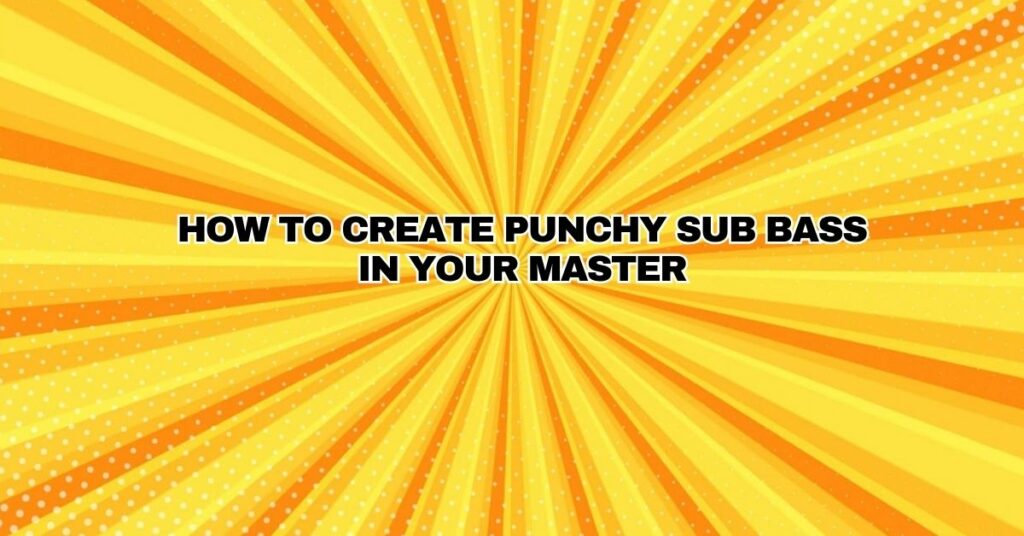Sub bass is a critical element of modern music production, providing depth and impact to the overall sound. Whether you’re producing electronic music, hip-hop, or any genre that relies on powerful low-end frequencies, creating a punchy sub bass in your master is essential for a polished and professional sound. In this comprehensive guide, we will delve into the art and techniques of crafting a punchy sub bass in your final mix, ensuring it’s impactful without overshadowing other elements.
Understanding the Role of Sub Bass
Before we dive into the techniques, it’s important to understand the role of sub bass in your music:
- Low-Frequency Foundation: Sub bass frequencies, typically below 60Hz, serve as the foundation of your mix. They provide the weight and power that make the track immersive and impactful.
- Groove and Rhythm: Sub bass is not just about feeling the rumble; it also plays a crucial role in defining the rhythm and groove of your music.
- Balance and Clarity: Crafting a punchy sub bass means achieving a balance between clarity and impact. It should be felt and heard without overwhelming other elements in the mix.
Step-by-Step Guide to Creating Punchy Sub Bass in Your Master
- Select the Right Source Sounds:
- Start with quality source sounds for your sub bass. Whether you’re using synthesized bass or recording live instruments, the source sound should have the necessary depth and clarity.
- Layering and Sound Design:
- Consider layering different bass sounds to create a richer and more textured sub bass. For example, combining a sine wave with a distorted or saturated bass can yield interesting results.
- Pay attention to the sound design, experimenting with filter settings, modulation, and harmonic content to sculpt the sub bass to your liking.
- Separate Sub Bass Channel:
- Isolate the sub bass on a separate channel or track. This allows you to process it separately from other elements in your mix.
- Equalization (EQ):
- Use a high-pass filter to eliminate any unwanted low-end content that may interfere with the sub bass.
- Apply a low-shelf EQ to boost the sub-bass frequencies, typically in the 40Hz to 60Hz range.
- Employ a parametric EQ to address any resonant or problematic frequencies in the sub bass.
- Consider a mid-side EQ to carve out space for the sub bass in the mix while retaining the stereo width of other elements.
- Compress and Sidechain:
- Apply gentle compression to the sub bass to even out the dynamics and ensure it’s consistently present in the mix.
- Use sidechain compression to create more space for the sub bass when other elements, like kick drums, occupy the same frequency range. This technique can enhance the punchiness of the sub bass.
- Saturation and Harmonic Exciters:
- Add subtle saturation or harmonic exciters to the sub bass to introduce harmonic content and make it more audible on various playback systems.
- Be cautious with the amount of saturation to avoid distortion or a cluttered mix.
- Volume Control:
- Adjust the volume level of the sub bass relative to the rest of the mix. It should be prominent but not overwhelming. Regular referencing on different playback systems is essential to achieve the right balance.
- Phase Alignment:
- Check the phase alignment of your sub bass with other elements in the mix. Misaligned phase can lead to cancellation and a weak sub bass sound.
- Use Monitoring Tools:
- Monitor the sub bass with spectrum analyzers and meters to visualize its frequency distribution. This ensures that it’s well-balanced and punchy without being excessively loud.
- Test on Various Systems:
- Test your mix on different playback systems, from studio monitors to headphones and car audio. This will help ensure that the sub bass translates well across different platforms.
- Reference Tracks:
- Use reference tracks from professional productions in the same genre to compare and fine-tune your sub bass. This can provide insights into the desired balance and punch.
Conclusion
Creating a punchy sub bass in your master is an art that combines sound design, mixing, and careful listening. When done correctly, it enhances the overall impact and depth of your music, elevating it to a professional standard. However, it’s important to remember that crafting sub bass is not a one-size-fits-all process. Each genre and track may require unique adjustments to achieve the perfect balance between depth and clarity.
With practice, experimentation, and a keen ear, you can master the art of punchy sub bass, making your music more immersive and engaging for your audience. As you refine your skills, you’ll find that crafting powerful sub bass becomes an integral part of your music production process, ensuring that your tracks hit hard and captivate listeners.


